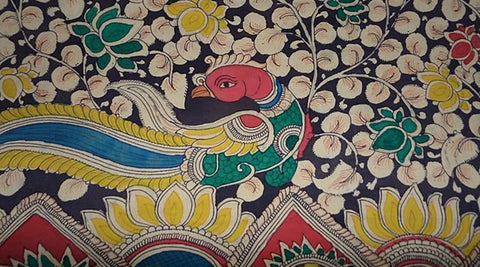GI is a tag used on products, which have a specific geographical origin, and ones that possess a reputation due to that origin.
The paintings are intricately made on a cotton cloth using pens or brushes made out of bamboo tree and coconut tree stems.
In Tamil Nadu, the Karuppur kalamkari paintings and the Kallakurichi wood carvings recently received the geographical indication (GI) tags. Both of these art forms are traditional in nature. While the paintings are intricately made on a cotton cloth using pens or brushes made out of bamboo tree and coconut tree stems, the wood carving is essentially one wherein the craftsmen are specialised in carving temple-related items and also furniture, using traditional designs.
According to a report in The Hindu, the application for registering Karuppur kalamkari paintings for the tag was moved by the Tamil Nadu Handicrafts Development Corporation (Poompuhar). It filed the application for Kallakurichi wood carvings jointly with the Kallakurichi Wood Carving Handicrafts Industrial Cooperative Limited Society, and the Chinnasalem and Vriksha Association of Wood Carving Artisans self-help group.
Explaining the process of kalamkari paintings, Meena Varma, gallery owner, Arts of the Earth, told indianexpress.com, The artists take a twig and wind a cloth around it and then dip it in the dye, which they make themselves. First, they treat the cotton cloth (canvas) by dipping it in milk and other things. It needs a lot of expertise. Varma, whose gallery was one of the first to promote folk and tribal art, continued, saying that these paintings are quite popular, but the style is mostly from Andhra Pradesh. Like most folk art, it is either temple art, or art for the home. The subjects are all mostly religious, but they also cover a bit of nature. The time to finish a painting depends on the intricacies and how big the canvas is.
According to the Tamil Nadu Weatherman, GI is a tag used on products with a specific geographical origin, and ones that possess a reputation due to that origin. Politician and Indian handicrafts curator Jaya Jaitly told this outlet that it is essentially a special status.
There is so much variety in India that anything, which is specialised to one area, and has a wonderfully-rich history, gets noted. So for giving it a status, GI is a good tool, she said.
Kalamkari means creating something with a kalam, or a brush. Traditionally, only three colours are used — black, red and yellow. But lately, ‘pale blue’ has also started being used, states the Tamil Nadu Weatherman.
Several other innovations and traditions from the state have also received the coveted tag, like the Kanyakumari cloves, Dindigul locks, Mahabalipuram stone sculpture, Nilgiri (orthodox) tea, Virupakshi hill banana, Thanjavur doll, Thanjavur paintings, Coimbatore wet grinder, Kancheepuram silk and saree, to name a few.
This content is originally posted at The New Indian Express.
Blogs you might also like:
Madhubani Paintings - A Brief Story of the Art
Magnificent Pattachitra Paintings of Orissa
Maharashtrian Tribal Art - Warli Paintings
The Madhubani Painting Heritage
 Verified Purchase
Verified Purchase
























Leave a comment (all fields required)